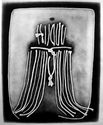
19th, 20th & 21st Century Fine Prints
707-546-7352 · fax 707-546-7924 · web: www.annexgalleries.com · email: artannex@aol.com
Adja Yunkers Biography
Adja Yunkers
American
1900–1983
Biography
Adja Yunkers was born Adolf Eduard Vilhelm Junker, in Riga, Latvia, on July 15th, 1900. He began drawing at an early age, from imagination and by studying the illustrations in books from his parents’ collection. He left home at age 14 to pursue a career in visual art, enrolling in what he later identified as the Imperial Academy of Arts in Petrograd (now St. Petersburg), but what may have been the Drawing School of the Society for the Enrichment of the Arts. The Drawing School kept no records, and later Yunkers would fabricate his credentials when he emigrated to the United States. In1919 he moved to Germany, where he had his first solo exhibition in 1921 at the Maria Kunde Galerie in Hamburg; with his earnings from the show he rented a studio. He became familiar with members of the Sturmgruppe, including Nolde, Schmidt, and Rottluff. He later participated in a large Russian avant-garde exhibition with Kandinksy, Archipenko, and Chagall.
He began to travel in 1923, going to Spain, the Canary Islands, Paris, and eventually Cuba in 1926, where he changed his name from “Junkers” to “Yunkers”. He lived there until 1927, when, with the rise in political upheaval and the persecution of Leftists, he fled Cuba for Mexico, where he met Diego Rivera. By the end of 1927 he had returned to Europe. He went briefly to Berlin, but the gaining power of the Nazi party spurred his move to Paris. He continued to work on various larger projects, murals for the City Hall in Ivry, and his woodcut series “The Ten Commandments”. In 1934 he immigrated to Sweden, where his reputation as a political artist and printmaker preceded him, and he was received with much enthusiasm. He remained in Sweden, while focusing primarily on printmaking, for the next 16 years. While living in Sweden he began to exhibit widely, quickly becoming recognized for his graphic work. His extensive collaborative work for various art publications kept him at the forefront of the European art world, and, despite a 1947 Stockholm studio fire that destroyed nearly ten years of work, he was able to continue to show that year. That summer, he moved to New York and began teaching at the New School for Social Research. His notoriety grew steadily, and his work was quickly acquired by several museums and private collections. He exhibited throughout the nation and abroad, and in 1953 he became a U.S. citizen. He founded the Rio Grande Workshop in Albuquerque, New Mexico (where he also taught) in 1949, publishing an entirely handmade art magazine called Prints in the Desert.
Yunkers was tireless in his creativity. While continuing to explore techniques and styles in printmaking (in 1960 he began learning lithography at Tamarind Workshop in New Mexico) as well as pastel drawing and painting, he took up teaching positions at the University of California, Berkeley, and Barnard College. He was invited to be a visiting lecturer at the University of Hawaii, Honolulu, and Columbia University. His work is included in private and public collections and museums, including the Bibliotheque Nationale, Paris; Brooklyn Museum, New york; Corcoran Gallery, Washington D.C.; Fine Arts Museum of San Francisco, California; Hamburg Kunsthalle, Germany; Rijksmuseum, Amsterdm; Smithsonian American Art Museum; Victoria and Albert Museum, England; and others.
Adja Yunkers died in New York City on December 24, 1983.








